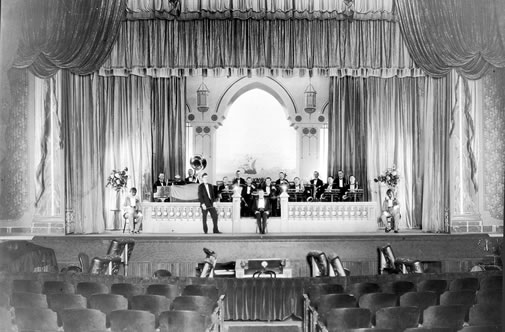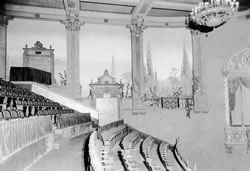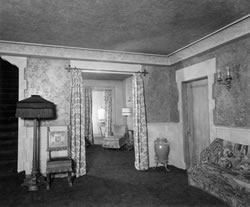Conference & Stage Expo
A Theatre Waiting for Rebirth

The Carolina Theatre will be the subject of a special Adaptive Reuse Design Charette session from 9:30 to 11 p.m. Friday, March 11 as part of the 2011 Annual Conference. The session is being organized by the Architecture Commission and will include work with architects, theatre consultants, and acousticians to develop a program, business plan, and a design. The session involves drawing and sharing of ideas, followed by presentations of the strategies.
If you stand on the corner of 6th and Tryon Streets in the very heart of downtown Charlotte, North Carolina you'll see it. It won't look like much, just a rectangular brick building, clay red with an unlit neon sign and some street level windows displaying toppled, moldy posters. You think that the tall section in the back might be a fly loft, and that door on the Sixth street side, chained and barred, certainly reminds you of some stage doors you've had the privilege to loiter by. The giveaway is on the side of the building facing Tryon Street: a poster with a fancy illustration of a condo development with a marquee. "Carolina Theatre," it says. "The best is yet to come!"



Photos of the Carolina Theatre, as it was several years ago, and as it is now, awaiting restoration.
Photos/Courtesy Carolina Theatre Preservation Society
At one time, the building was one of the community's best-loved entertainment options opening in 1927 to record crowds. The design was a joint effort between C. C. Hook, preeminent Charlotte architect, and R. E. Hall, famed New York theatre designer. Mr. Hook styled the exterior of the theatre to mimic three separate storefronts done in the Spanish Renaissance style with a brilliantly lit marquee. The storefronts led into a luxurious lobby, all gilt and palatial Venetian. The theatre itself was ornately columned displaying stunning murals of dark cypress trees and flowering vines that evoked a Mediterranean palazzo under the azure blue sky darkening just before dusk.
It was the first commercial building in town with air conditioning, and folks came from all over to enjoy its luxury. The 1,450-seat theatre offered a respite from the hot Southern air and an escape into fiction six nights a week. All the best Hollywood features played there. The Sound of Music played a record 79-week run attracting more audience members than lived in the county. Most weekends, the local vaudeville company would put on a show and road shows kept the audiences coming back to see talents like Elvis Presley, Bob Hope, Orson Welles, and Ethel Barrymore. The Carolina became the first racially integrated theatre in the region.
The Carolina reigned over the Queen City for many decades. Over the years, modifications were made and parts of the original architecture and decor were lost to upgrades in the technological systems of the theatre. Then slowly, things began to change. Middle class families began to flee to the suburbs, spent less time Uptown. In 1972 the theatre almost closed but Kermit High, the manager for many years, stepped in and took ownership. Even he had to let it go in 1978, and it has been vacant ever since.
In 1980, vagrants set a fire in the back of the building, destroying the original stage but leaving the structure intact. In 1988 the lobby was torn down leaving only the theatre and the façade standing. The façade, which was briefly on the Local Historical Register and then taken off to accommodate "progress," was carefully taken down and put inside the theatre so it could be put back in place when the theatre is restored. It was about to fall down by itself, so the city paid to take it down. All that remains in its place is asphalt black top surrounded by a chain link.
For 33 years the theatre has sat empty. As it languished, other theatres were born. The North Carolina Blumenthal Performing Arts Center has an outstanding facility with three theatres on Tryon Street, built in 1992. The Children's Theatre of Charlotte moved to a brand new, state-of-the art facility on 7th Street in 2005. And just a short time ago, the Blumenthal added another facility to its collection; the Knight Theater, that seats 1,150 just a few short blocks down Tryon Street from the Carolina.
Many attempts to use the Carolina Theatre in some capacity have been made. The Carolina was almost torn down to be a bank; almost restored to be a restaurant or a nightclub, and in 1999 was almost a performing arts center. The Carolina Theatre Preservation Society, founded in 1997 by local businessman Charlie Clayton, has been trying to save the theatre for almost 14 years. They were close a few years ago with the Encore Project, a condo development that would have been attached to the theatre and financed its restoration, except the economy tanked and the project stalled. Funding, developers, and projects have all come and gone.
Charlotte, the nation's second largest banking center, has struggled to define itself often destroying its past. The Carolina sits and waits for action. Take a moment while in Charlotte to stand at the corner of 6th and Tryon and look upon the shell of the Carolina. For more information on the Carolina Theatre and the fight to save it, please www.carolinatheatre.us.



